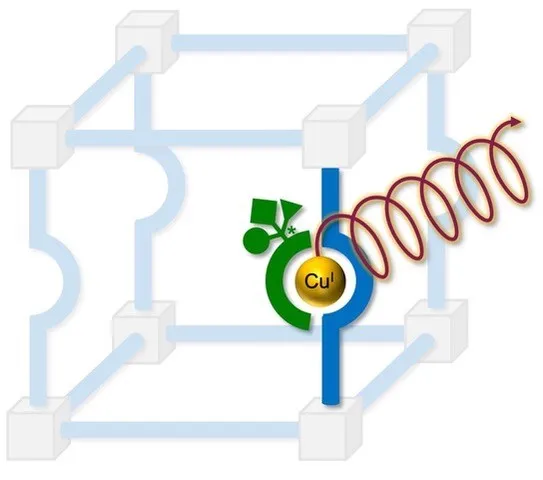Circularly polarized triplet exciton emission from MOF-immobilized and -organized chiral copper(I) complexes
| Consortium: | |
| JProf. Sebastian Henke, Dortmund Technische Universität Dortmund Fakultät für Chemie und Chemische Biologie, Anorganische Chemie | |
| Prof. Andreas Steffen, Dortmund Technische Universität Dortmund Fakultät für Chemie und Chemische Biologie, Lehrstuhl für Anorganische Chemie | |
| Project: | Circularly polarized triplet exciton emission from MOF-immobilized and -organized chiral copper(I) complexes |
| Abstract: | Excited states of chiral photoactive compounds are of great interest because they can exhibit circularly polarized luminescence (CPL) with a yet to fully explore potential in enantioselective sensors, data storage, (3D-)OLEDs, or ultrafast switching in quantum cryptographical applications. The majority of current CPL compounds is based on fluorescent states and lanthanides, both of which are not the optimal choice for optoelectronic applications. However, the design of phosphorescent CPL materials with high quantum yield and high radiative rate constants is much less explored as the formally spin-forbidden T1 emission requires coupling with Sn states of sufficient electronic transition dipole moment to the ground state, while each of them may have a different orientation of the magnetic transition dipole moment m (leading to partial cancellation of the overall m) that is necessary for strong CPL. Therefore, prediction of the extent of CP phosphorescence or even CP-TADF (thermally activated delayed fluorescence) is difficult, and the few examples known show relatively weak CPL. Metal-organic frameworks (MOFs) are promising platforms for the targeted design of novel materials with advanced photophysical properties, such as lasing, multi-photon absorption and guest, temperature or pressure dependent luminescence. The immobilization of photoactive molecular luminophores in a rigid crystalline coordination network can significantly improve their luminescence parameters (luminescence lifetime, quantum yield, etc.) due to increased photo-stability, a suppression of non-radiative deactivation as well as a targeted alignment and arrangement of the luminophores in 3D space. Within this collaborative project, we aim to combine our expertise for the construction of porous MOFs containing chiral highly efficient organometallic Cu(I) luminophores, which can emit from their T1 state or via TADF, arranged in a three-dimensional lattice. For this, we will follow a very specific design strategy to obtain beneficial CPL properties in single crystals, powders and films, and employ these new materials in CP-PhOLEDs. |
| Publications: | |
| L. Frentzel-Beyme, M. Kloss, P. Kolodzeiski, R. Pallach, S. Henke “Meltable Mixed-Linker Zeolitic Imidazolate Frameworks and Their Microporous Glasses - From Melting Point Engineering to Selective Hydrocarbon Sorption” J. Am. Chem. Soc. 2019, 141, 12362-12371 DOI: 10.1021/jacs.9b05558 | |
| L. Frentzel-Beyme, M. Kloß, R. Pallach, S. Salamon, H. Moldenhauer, J. Landers, H. Wende, J. Debus, S. Henke “Porous purple glass - A cobalt imidazolate glass with accessible porosity from a meltable cobalt imidazolate framework” J. Mater. Chem. A 2019, 7, 985-990 DOI: 10.1039/C8TA08016J | |
| R. Medishetty, V. Nalla, L. Nemec, S. Henke, D. Mayer, H. Sun, K. Reuter, R. A. Fischer “A New Class of Lasing Materials: Intrinsic Stimulated Emission from Nonlinear Optically Active Metal–Organic Frameworks” Adv. Mater. 2017, 56, 14743-14748 DOI: 10.1002/adma.201605637 | |
| R. Medishetty, L. Nemec, V. Nalla, S. Henke, M. Samoc, K. Reuter, R. A. Fischer “Multi-Photon Absorption in Metal-Organic Frameworks” Angew. Chem., Int. Ed. 2017, 56, 14743-13748 DOI: 10.1002/anie.201706492 | |
| M. Gernert, L. Balles-Wolf, F. Kerner, U. Müller, A. Schmiedel, M. Holzapfel, C. M. Marian, J. Pflaum, C. Lambert, A. Steffen „Cyclic (Amino)(aryl)carbenes Enter the Field of Chromophore Ligands: Expanded π System Leads to Unusually Deep Red Emitting CuI Compounds”, J. Am. Chem. Soc. 2020, 142, 19, 8897-8909 DOI: 10.1021/jacs.0c02234 | |
| A. Steffen, B. Hupp “Design of Efficient Emissive Materials” Comprehensive Coordination Chemistry III 2020 DOI: 10.1016/B978-0-12-409547-2.14753-5 | |
| B. Hupp, J. Nitsch, T. Schmitt, R. Bertermann, K. Edkins, F. Hirsch, I. Fischer, M. Auth, A. Sperlich, A. Steffen “Stimulus‐Triggered Formation of an Anion–Cation Exciplex in Copper(I) Complexes as a Mechanism for Mechanochromic Phosphorescence” Angew. Chem. Int. Ed. 2018, 57, 13671 DOI: 10.1002/anie.201807768 | |
| M. Gernert, U. Müller, M. Haehnel, J. Pflaum, A. Steffen “A Cyclic Alkyl(Amino)Carbene as Two-Atom-pi-Chromophore Leading to the First Phosphorescent Linear Cu(I) Complexes” Chem. Eur. J. 2017, 23, 2206 DOI: 10.1002/chem.201605412 | |
| J. Nitsch, F. Lacemon, A. Lorbach, A. Eichhorn, F. Cisnetti, A. Steffen “Cuprophilic Interactions in Highly Luminescent Dicopper(I)-NHC-picolyl Complexes – Fast Phosphorescence or TADF?” Chem. Commun. 2016, 52, 2932 DOI: 10.1039/C5CC09659F |
